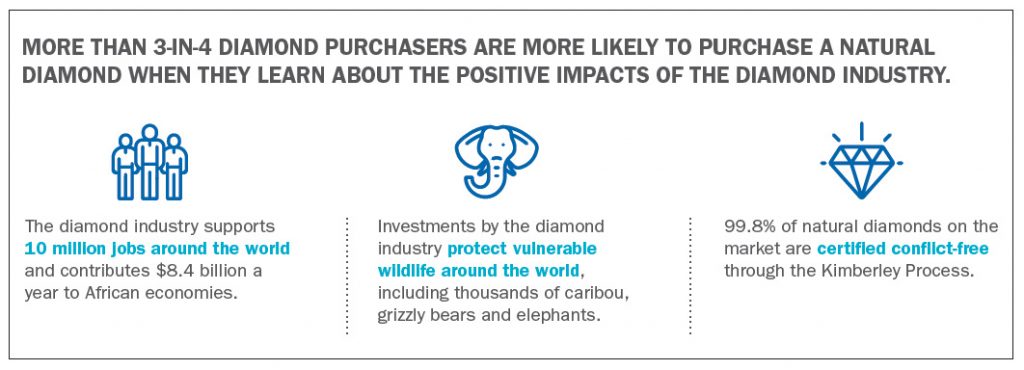The Diamond Producers Association (DPA) and KRC Research released the findings of a new survey which states that over 53 million Americans (21%) plan to purchase a diamond between Thanksgiving (November 22nd, 2018) and Valentine’s Day (February 14th, 2019). According to the report, men and millennials are most likely to purchase diamonds this holiday season. Of the Americans who plan to buy a diamond, more than 20 million plan to buy a diamond engagement ring.
The survey confirmed that there is clear confusion among diamond purchasers about the differences between natural diamonds and laboratory-created diamonds, including differences in value, rarity, physical growth structure and origin.
“Diamonds shine especially bright this year,” said gemmologist and diamond expert Grant Mobley. “Consumers, especially millennials, are seeking ways to share authentic, emotional and lasting symbols of love with the special people in their lives.”
But Mobley warned that the arrival of synthetic or lab-grown diamonds can cause confusion among consumers at the jewellery counter. He urged diamond shoppers to do their homework, so that they can ensure they are confidently buying a natural diamond.
Nearly half of diamond purchasers (44%) were unaware of the significant differences in value, rarity, physical growth structure and origin between natural diamonds and laboratory-created stones. However, more than seven in ten (71%) became more likely to buy a natural diamond over a laboratory-created diamond as they learned the differences.
The key differences between natural diamonds and laboratorycreated diamonds include:
- Natural diamonds are significantly more valuable than laboratory-created diamonds.
- Each natural diamond is rare because it is unique and authentic; laboratory-created diamonds are not rare because they can be made in unlimited quantities. Natural diamonds can take millions or even billions of years to be created in the earth; laboratory-created diamonds are typically made in two weeks.
- Natural diamonds and laboratory-created diamonds have easily detectable differences in their physical growth structures.
The survey found that threequarters (78%) of Americans are more likely to consider purchasing a natural diamond once they learn of the positive social, economic and wildlife conservation impacts of the diamond industry. Key facts that influence purchasing decisions include:
- The diamond industry supports 10 million jobs around the world and contributes $8.4 billion a year to African economies.
- Investments by the diamond industry protect vulnerable wildlife around the world, including thousands of caribou, grizzly bears, and elephants.
- 99.8% of diamonds on the market are certified conflictfree through the Kimberley Process (KP).
Conducted from November 5th-7th by KRC Research, the survey assessed a nationally representative population of over 1,000 US adults aged 18 and above. The new survey adds to a body of credible and statistically significant surveys conducted by the DPA. This research underpins the steady demand for diamonds, appreciation for the positive impact of the diamond industry, and the need for transparency about the differences between natural diamonds and laboratorymade diamonds.


